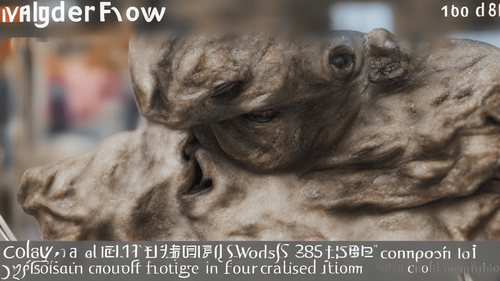
Introduction
In the ever-evolving landscape of artificial intelligence, a remarkable innovation has emerged that has captured the imagination of artists and tech enthusiasts alike: AI that draws pictures from words. This groundbreaking technology merges the power of AI algorithms with the boundless realm of human creativity, giving rise to awe-inspiring works of art that originate from mere textual descriptions. In this comprehensive article, we delve deep into the realm of AI-generated art, exploring its inner workings, applications, implications, and the profound impact it's having on the world of creativity.
AI That Draws Pictures from Words: Unleashing Imagination
Unraveling the Concept of AI-Powered Art
AI that draws pictures from words is a transformative concept that fuses natural language processing (NLP) and computer vision to give life to vivid visual representations based solely on textual input. This innovative technology utilizes advanced deep learning models to comprehend and interpret descriptive language, effectively translating it into stunning visual masterpieces.
The Birth of a New Artistic Medium
Traditional art forms have long been a medium for human expression, but AI-generated art introduces a new dimension to the creative landscape. By bridging the gap between language and visual representation, AI offers a canvas for thoughts and ideas to be translated into captivating images, fostering a realm of artistic exploration that knows no bounds.
AI Artistry: A Fusion of Algorithms and Imagination
At the heart of AI-generated art lies a fusion of intricate algorithms and human-like imagination. These algorithms, often rooted in generative adversarial networks (GANs) or transformer models, analyze descriptive language and engage in a creative dialogue with the AI's neural network, resulting in a process akin to a virtual artist translating words into brushstrokes.
The Inner Workings of AI-Generated Art
Decoding Descriptive Language: The NLP Component
The journey of transforming words into images commences with the NLP component of AI. Natural language processing algorithms dissect and interpret the descriptive input, identifying key elements, emotions, and concepts embedded within the text.
From Pixels to Perception: The Role of Computer Vision
Once the linguistic input is deciphered, the AI seamlessly transitions to the realm of computer vision. This facet of the technology is responsible for converting textual descriptions into a visual format, considering aspects such as colors, shapes, perspectives, and spatial relationships.
The Creative Dialogue: GANs and Beyond
Generative adversarial networks (GANs) play a pivotal role in the creative process of AI-generated art. GANs facilitate a dynamic interplay between two neural networks – a generator and a discriminator – essentially fostering a digital artistry conversation where the generator aims to produce images that the discriminator perceives as authentic, resulting in a continuous refinement of the artistic output.
Applications of AI-Driven Visual Creativity
A New Dawn in Visual Storytelling
AI-generated art transcends conventional artistic expression, finding its place in the realm of visual storytelling. Authors and storytellers can now breathe life into their narratives by transforming textual descriptions into compelling visual aids, enriching the reader's experience and engagement.
Bridging Language Barriers through Imagery
Language barriers have often hindered effective communication, but AI-powered art has the potential to bridge this gap. By illustrating concepts and ideas through visual imagery, even the most complex subjects can be conveyed universally, transcending linguistic limitations.
Artistic Collaborations: Humans and Machines
The collaboration between human creativity and AI artistry opens doors to new dimensions of artistic exploration. Artists can use AI-generated visuals as a foundation, infusing their personal style and emotions to create unique amalgamations that push the boundaries of creativity.
The Ethical Implications and Controversies
Authorship and Attribution in the Digital Age
As AI-generated art gains prominence, questions surrounding authorship and attribution come to the forefront. Determining the rightful creator of a piece becomes intricate, raising ethical concerns about the nature of artistic ownership and the role of AI in the creative process.
Originality vs. Replication: A Delicate Balance
Critics argue that AI-generated art treads a fine line between originality and replication. While AI has the capacity to emulate established artistic styles, the question of true creativity – the ability to conceptualize something entirely new – remains a subject of debate.
The Human Touch: Emotion and Artistic Expression
A prevailing contention revolves around the essence of human emotion and expression in art. Can AI truly replicate the depth of emotion that a human artist infuses into their work, or does the technological process inherently lack the nuances that make art profoundly human?
FAQs
How does AI create art from text descriptions?
AI utilizes advanced algorithms and neural networks to interpret text descriptions, translating them into visual representations by analyzing colors, shapes, and other visual elements.
Can AI-generated art be considered authentic creativity?
AI-generated art showcases a unique form of creativity, blending human-provided input with machine-generated interpretations to produce novel visual outputs.
Are AI artists poised to replace human artists?
AI artists are unlikely to replace human artists. Instead, they complement and expand artistic possibilities, fostering collaboration and pushing creative boundaries.
What are some popular platforms utilizing AI for art generation?
Platforms like DeepArt, Runway ML, and Artbreeder are popular examples that leverage AI to create art, enabling users to experiment with AI-driven creativity.
Do AI-generated artworks have any commercial value?
AI-generated artworks have begun to hold commercial value, with some pieces being sold at auctions. The perceived value often stems from the interplay of technology and creativity.
How might AI-generated art impact the traditional art world?
AI-generated art is reshaping the traditional art landscape by introducing new modes of expression and challenging conventional notions of creativity and authorship.
Conclusion
In the realm of AI that draws pictures from words, the convergence of human imagination and technological prowess paves the way for an extraordinary era of creativity. As AI-generated art continues to make its mark, it redefines the boundaries of artistic expression, enriching storytelling, fostering cross-cultural understanding, and inviting us to question the very essence of creativity itself. In this dynamic interplay between algorithms and ingenuity, the future of art unfolds, promising an artistic journey that is as captivating as it is innovative.